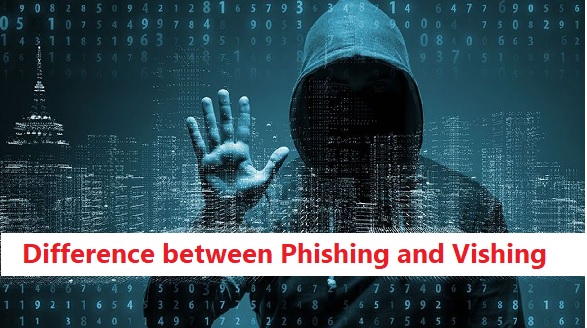Know the Differences between Phishing and Vishing

The world is moving towards digitization at a rapid pace. With this fast digital advancement, some new problems related to cyber threats are being faced by users globally. These cyber threats are diverse in nature and attack users in one form or another. Both Phishing and Vishing are different forms of these cyber threats. Every year, thousands of internet users fall for these threats and end up being victims of Cyber Crimes.
The motive of both Phishing and Vishing is the same i.e to lure victims to reveal their personal, sensitive, and confidential data. Scammers then use this data for their benefit in different ways. As per a report published in the United States, people have lost $45 million in a year due to Phishing and Vishing.
Talking about the difference, we can say that Phishing and Vishing are two differences with the same motive. To keep these scams at bay, you need to understand the scammer’s methodologies. Go through this post to understand details about Phishing, Vishing, and how are they different from each other.
About Phishing
Let’s go through these scams in detail. First, we will discuss phishing.
- In simple language, we can say that phishing is a method in which a scammer poses as an institution and try to convince the victim to share his sensitive, personal, and confidential data. Then, he use this data to conduct various kinds of fraud including financial fraud.
- Please note that Phishing is a broad term for various kinds of cyber calling causing trouble to organizations and the general public. A scammer can use a phone call, email, voice mail or other methods to contact the victim.
List of Best Email Clients for Windows 10
Key Goal of Phishing
- The main goal of the scammer is to take the information from the victim.
- He tries to pretend as a trusty worthy person initially. Then, he convinces the victim to share the data.
- After getting the data, scammers got control over the victim and ask them to do whatever they want.
- Generally, scammers use this technique for financial benefits.
Types of Phishing
- There are multiple types of phishing that are prevalent on the Internet today.
- The most common types of phishing are voice phishing and email phishing.
- Apart from this, spear phishing, clone phishing, whaling, and many more kinds of phishing techniques are also used by scammers.
About Vishing
Now, let’s know about Vishing.
- We can say that Vishing is a specific type of phishing. The term Vishing is made of two words i.e. Voice and Phishing.
- In this scam, the scammer uses phone calls to convince victims to share confidential data such as debit/ credit card information, etc. After that, scammers use this data to conduct various kinds of financial frauds or ask victims to do whatever they want.
Methodology and Objectives of Vishing
- It is a long and meticulous process, the scammer poses himself as an employee of a bank or other institutions and tries to win the trust of the user.
- After gaining the trust, he asks them to share information like bank and credit/ debit card details, OTP, UPI ID, etc.
- Most of the Vishing attack takes place through a voice-over-IP (VOIP) system. Apart from this, they also use spoof phone numbers generated using a computer system to contact the victims.
- Just like Phishing, the motive of Vishing is also the same that is to take confidential information from the victim.
- The main element of Vishing is manipulation and trickery to fall victims to reveal their personal and confidential information.
Types of Vishing
- Most common modus operandi of Vishing scammers is to call the victim over the phone using fake phone numbers.
- In addition to this, various other mediums are also used such as skype, zoom, and so on.
Major Differences between Phishing and Vishing?
All the main differences between Vishing and Phishing are as follows.
| Phishing | Vishing |
| Primarily use emails to trick people into giving up their information | Uses verbal communication through the whole scam takes place |
| Victims need to click on the malicious link present in the phishing email | Victims tell their confidential information over the phone. |
| This is an automated attack | It is a manual attack |
| A single scammer can send phishing emails to thousands of users at once | Voice calls can be done to target one person by an attacker |
| It is more used by scammers nowadays | It was mostly used in earlier days. However, attacker |
| Mostly the scammer involved in phishing are cyber criminals or professional hackers | Most of the Vishing attackers are not experts in hacking. |
Ways to save yourself from Phishing and Vishing?
Here are some tips and tricks that you may follow in order to save yourself from Phishing and Vishing.
- Install good antivirus software on your computer system. An antivirus is designed to track phishing websites and alert you beforehand.
- Keep updating the software of your mobile phone No matter you are using android or iOS, you should update your phone regularly. It is so because new updates come with security patches useful in protecting you against phishing.
- Protect your account with 2-factor authentication. If you enable this feature, the hacker will not be able to access the information available on your account even if he knows your password.
- Take a backup of your data so that you can get it back in case of any security breach.
- Never ever share any of your confidential details over the phone. Remember, even the bank employees will never ask you these details on the phone.
- Spreading awareness is the best tool against Phishing and Vishing. Make your family and friends aware of these frauds.




